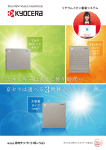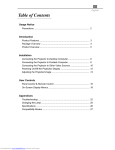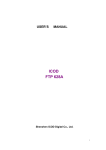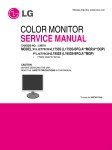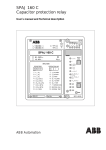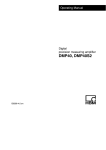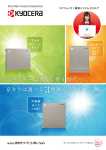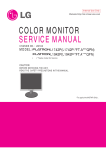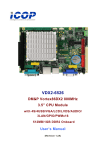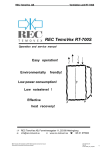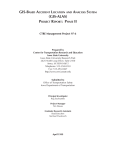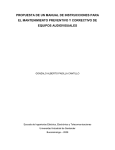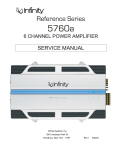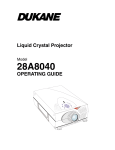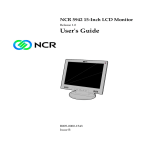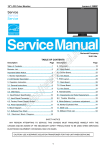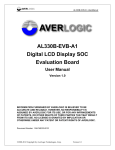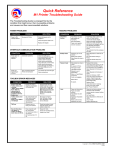Download l1753s
Transcript
Website:http://biz.LGservice.com COLOR MONITOR SERVICE MANUAL CHASSIS NO. : LM57A MODEL: L1753S (L1753S-*FS.A***QP) L1953S (L1953S-*FS.A***QP) ( ) **Same model for Service CAUTION BEFORE SERVICING THE UNIT, READ THE SAFETY PRECAUTIONS IN THIS MANUAL. *To apply the MSTAR Chip. CONTENTS SPECIFICATIONS ................................................... 2 PRECAUTIONS ....................................................... 3 TIMING CHART ....................................................... 7 DISASSEMBLY ........................................................ 8 BLOCK DIAGRAM...................................................12 DISCRIPTION OF BLOCK DIAGRAM .................. 13 ADJUSTMENT ...................................................... 16 SERVICE OSD ........................................................17 TROUBLESHOOTING GUIDE .............................. 18 WIRING DIAGRAM ............................................... 24 EXPLODED VIEW...................................................25 REPLACEMENT PARTS LIST ...............................27 SCHEMATIC DIAGRAM ......................................... 31 SPECIFICATIONS 1. LCD CHARACTERISTICS Type : TFT Color LCD Module Active Display Area : 17 inch - L1753S : 19 inch - L1953S Pixel Pitch : 0.264 (H) x 0.264 (V) - L1753S : 0.294 (H) x 0.294 (V) - L1953S Color Depth : 8bits, 16.2M colors Size : 358.5 (H) x 296.5 (V) x 17.0(D) - L1753S : 396 (H) x 324 (V) x 17.5(D) - L1953S Electrical Interface : LVDS Surface Treatment : Hard-coating(3H), Anti-Glare Operating Mode : Normally White, Transmissive mode Backlight Unit : 4-CCFL 4. Max. Resolution D-sub Analog 5. POWER SUPPLY 5-1. Power : AC 100~240V, 50/60Hz , 0.6A 5-2. Power Consumption MODE POWER ON (NORMAL) 2. OPTICAL CHARACTERISTICS 2-1. Viewing Angle by Contrast Ratio ≥ 10 : 230(min), 300(Typ) (Full White pattern, 0.70V) -6500K : 150(min) (Full White pattern, 0.70V) -9300K 75%(min) 2-3. Contrast Ratio : 2000:1 (DFC) 3. SIGNAL (Refer to the Timing Chart) 3-1. Sync Signal • Type : Separate Sync, SOG 3-2. Video Input Signal 1) Type 2) Voltage Level a) Color 0, 0 b) Color 7, 0 c) Color 15, 0 3) Input Impedance : R, G, B Analog : 0~0.71 V : 0 Vp-p : 0.467Vp-p : 0.714Vp-p : 75Ω 3-3. Operating Frequency Horizontal : 30 ~ 83kHz Vertical : 56 ~ 75Hz H/V SYNC VIDEO POWER CONSUMPTION LED COLOR ON/ON ACTIVE less than 35 W -L1753S BLUE less than 39 W -L1953S or GREEN STAND-BY OFF/ON OFF less than 1 W AMBER SUSPEND ON/OFF OFF less than 1 W AMBER DPMS OFF OFF/OFF OFF less than 1 W AMBER less than 1 W OFF POWER S/W Off Left : -60° min., -70°(Typ) Right : +60° min., +70°(Typ) Top :+60° min., +75°(Typ) Bottom : -50° min., -65°(Typ) 2-2. Luminance : 1280 x 1024@75Hz - - 6. ENVIRONMENT 6-1. Operating Temperature : 10°C~35°C (50°F~95°F) (Ambient) 6-2. Relative Humidity : 10%~80% (Non-condensing) 6-3. MTBF : 50,000 HRS with 90% Confidence Lamp Life : 50,000 Hours(Min) 7. DIMENSIONS (with TILT/SWIVEL) L1753S Width : 364.5 mm (14.35'') Depth : 180 mm (7.09'') Height : 378.2 mm (14.89'') L1953S Width Depth Height : 402 mm (15.83'') : 180 mm (7.09'') : 407.5 mm (16.04'') 8. WEIGHT (with TILT/SWIVEL) L1753S Net. Weight : 3.3 kg (7.28 lbs) Gross Weight : 4.4 kg (9.70 lbs) L1953S Net. Weight Gross Weight -2- : 4.2 kg (9.26 lbs) : 5.4 kg (11.91 lbs) PRECAUTION WARNING FOR THE SAFETY-RELATED COMPONENT. WARNING • There are some special components used in LCD monitor that are important for safety. These parts are marked on the schematic diagram and the replacement parts list. It is essential that these critical parts should be replaced with the manufacturer’s specified parts to prevent electric shock, fire or other hazard. • Do not modify original design without obtaining written permission from manufacturer or you will void the original parts and labor guarantee. BE CAREFUL ELECTRIC SHOCK ! • If you want to replace with the new backlight (CCFL) or inverter circuit, must disconnect the AC adapter because high voltage appears at inverter circuit about 650Vrms. • Handle with care wires or connectors of the inverter circuit. If the wires are pressed cause short and may burn or take fire. Leakage Current Hot Check Circuit TAKE CARE DURING HANDLING THE LCD MODULE WITH BACKLIGHT UNIT. AC Volt-meter • Must mount the module using mounting holes arranged in four corners. • Do not press on the panel, edge of the frame strongly or electric shock as this will result in damage to the screen. • Do not scratch or press on the panel with any sharp objects, such as pencil or pen as this may result in damage to the panel. • Protect the module from the ESD as it may damage the electronic circuit (C-MOS). • Make certain that treatment person’s body are grounded through wrist band. • Do not leave the module in high temperature and in areas of high humidity for a long time. • The module not be exposed to the direct sunlight. • Avoid contact with water as it may a short circuit within the module. • If the surface of panel become dirty, please wipe it off with a softmaterial. (Cleaning with a dirty or rough cloth may damage the panel.) CAUTION Please use only a plastic screwdriver to protect yourself from shock hazard during service operation. -3- Good Earth Ground such as WATER PIPE, CONDUIT etc. To Instrument’s exposed METALLIC PARTS 1.5 Kohm/10W SERVICING PRECAUTIONS CAUTION: Before servicing receivers covered by this service manual and its supplements and addenda, read and follow the SAFETY PRECAUTIONS on page 3 of this publication. NOTE: If unforeseen circumstances create conflict between the following servicing precautions and any of the safety precautions on page 3 of this publication, always follow the safety precautions. Remember: Safety First. General Servicing Precautions 1. Always unplug the receiver AC power cord from the AC power source before; a. Removing or reinstalling any component, circuit board module or any other receiver assembly. b. Disconnecting or reconnecting any receiver electrical plug or other electrical connection. c. Connecting a test substitute in parallel with an electrolytic capacitor in the receiver. CAUTION: A wrong part substitution or incorrect polarity installation of electrolytic capacitors may result in an explosion hazard. d. Discharging the picture tube anode. 2. Test high voltage only by measuring it with an appropriate high voltage meter or other voltage measuring device (DVM, FETVOM, etc) equipped with a suitable high voltage probe. Do not test high voltage by "drawing an arc". 3. Discharge the picture tube anode only by (a) first connecting one end of an insulated clip lead to the degaussing or kine aquadag grounding system shield at the point where the picture tube socket ground lead is connected, and then (b) touch the other end of the insulated clip lead to the picture tube anode button, using an insulating handle to avoid personal contact with high voltage. 4. Do not spray chemicals on or near this receiver or any of its assemblies. 5. Unless specified otherwise in this service manual, clean electrical contacts only by applying the following mixture to the contacts with a pipe cleaner, cottontipped stick or comparable non-abrasive applicator; 10% (by volume) Acetone and 90% (by volume) isopropyl alcohol (90%-99% strength) CAUTION: This is a flammable mixture. Unless specified otherwise in this service manual, lubrication of contacts in not required. 6. Do not defeat any plug/socket B+ voltage interlocks with which receivers covered by this service manual might be equipped. 7. Do not apply AC power to this instrument and/or any of its electrical assemblies unless all solid-state device heat sinks are correctly installed. 8. Always connect the test receiver ground lead to the receiver chassis ground before connecting the test receiver positive lead. Always remove the test receiver ground lead last. 9. Use with this receiver only the test fixtures specified in this service manual. CAUTION: Do not connect the test fixture ground strap to any heat sink in this receiver. Electrostatically Sensitive (ES) Devices Some semiconductor (solid-state) devices can be damaged easily by static electricity. Such components commonly are called Electrostatically Sensitive (ES) Devices. Examples of typical ES devices are integrated circuits and some field-effect transistors and semiconductor "chip" components. The following techniques should be used to help reduce the incidence of component damage caused by static by static electricity. 1. Immediately before handling any semiconductor component or semiconductor-equipped assembly, drain off any electrostatic charge on your body by touching a known earth ground. Alternatively, obtain and wear a commercially available discharging wrist strap device, which should be removed to prevent potential shock reasons prior to applying power to the unit under test. 2. After removing an electrical assembly equipped with ES devices, place the assembly on a conductive surface such as aluminum foil, to prevent electrostatic charge buildup or exposure of the assembly. 3. Use only a grounded-tip soldering iron to solder or unsolder ES devices. 4. Use only an anti-static type solder removal device. Some solder removal devices not classified as "antistatic" can generate electrical charges sufficient to damage ES devices. 5. Do not use freon-propelled chemicals. These can generate electrical charges sufficient to damage ES devices. 6. Do not remove a replacement ES device from its protective package until immediately before you are ready to install it. (Most replacement ES devices are packaged with leads electrically shorted together by conductive foam, aluminum foil or comparable conductive material). 7. Immediately before removing the protective material from the leads of a replacement ES device, touch the protective material to the chassis or circuit assembly into which the device will be installed. CAUTION: Be sure no power is applied to the chassis or circuit, and observe all other safety precautions. 8. Minimize bodily motions when handling unpackaged replacement ES devices. (Otherwise harmless motion such as the brushing together of your clothes fabric or the lifting of your foot from a carpeted floor can generate static electricity sufficient to damage an ES device.) -4- General Soldering Guidelines 1. Use a grounded-tip, low-wattage soldering iron and appropriate tip size and shape that will maintain tip temperature within the range or 500 F to 600 F. 2. Use an appropriate gauge of RMA resin-core solder composed of 60 parts tin/40 parts lead. 3. Keep the soldering iron tip clean and well tinned. 4. Thoroughly clean the surfaces to be soldered. Use a mall wire-bristle (0.5 inch, or 1.25cm) brush with a metal handle. Do not use freon-propelled spray-on cleaners. 5. Use the following unsoldering technique a. Allow the soldering iron tip to reach normal temperature. (500 F to 600 F) b. Heat the component lead until the solder melts. c. Quickly draw the melted solder with an anti-static, suction-type solder removal device or with solder braid. CAUTION: Work quickly to avoid overheating the circuitboard printed foil. 6. Use the following soldering technique. a. Allow the soldering iron tip to reach a normal temperature (500 F to 600 F) b. First, hold the soldering iron tip and solder the strand against the component lead until the solder melts. c. Quickly move the soldering iron tip to the junction of the component lead and the printed circuit foil, and hold it there only until the solder flows onto and around both the component lead and the foil. CAUTION: Work quickly to avoid overheating the circuit board printed foil. d. Closely inspect the solder area and remove any excess or splashed solder with a small wire-bristle brush. IC Remove/Replacement Some chassis circuit boards have slotted holes (oblong) through which the IC leads are inserted and then bent flat against the circuit foil. When holes are the slotted type, the following technique should be used to remove and replace the IC. When working with boards using the familiar round hole, use the standard technique as outlined in paragraphs 5 and 6 above. Removal 1. Desolder and straighten each IC lead in one operation by gently prying up on the lead with the soldering iron tip as the solder melts. 2. Draw away the melted solder with an anti-static suction-type solder removal device (or with solder braid) before removing the IC. Replacement 1. Carefully insert the replacement IC in the circuit board. 2. Carefully bend each IC lead against the circuit foil pad and solder it. 3. Clean the soldered areas with a small wire-bristle brush. (It is not necessary to reapply acrylic coating to the areas). "Small-Signal" Discrete Transistor Removal/Replacement 1. Remove the defective transistor by clipping its leads as close as possible to the component body. 2. Bend into a "U" shape the end of each of three leads remaining on the circuit board. 3. Bend into a "U" shape the replacement transistor leads. 4. Connect the replacement transistor leads to the corresponding leads extending from the circuit board and crimp the "U" with long nose pliers to insure metal to metal contact then solder each connection. Power Output, Transistor Device Removal/Replacement 1. Heat and remove all solder from around the transistor leads. 2. Remove the heat sink mounting screw (if so equipped). 3. Carefully remove the transistor from the heat sink of the circuit board. 4. Insert new transistor in the circuit board. 5. Solder each transistor lead, and clip off excess lead. 6. Replace heat sink. Diode Removal/Replacement 1. Remove defective diode by clipping its leads as close as possible to diode body. 2. Bend the two remaining leads perpendicular y to the circuit board. 3. Observing diode polarity, wrap each lead of the new diode around the corresponding lead on the circuit board. 4. Securely crimp each connection and solder it. 5. Inspect (on the circuit board copper side) the solder joints of the two "original" leads. If they are not shiny, reheat them and if necessary, apply additional solder. Fuse and Conventional Resistor Removal/Replacement 1. Clip each fuse or resistor lead at top of the circuit board hollow stake. 2. Securely crimp the leads of replacement component around notch at stake top. 3. Solder the connections. CAUTION: Maintain original spacing between the replaced component and adjacent components and the circuit board to prevent excessive component temperatures. -5- Circuit Board Foil Repair Excessive heat applied to the copper foil of any printed circuit board will weaken the adhesive that bonds the foil to the circuit board causing the foil to separate from or "lift-off" the board. The following guidelines and procedures should be followed whenever this condition is encountered. At IC Connections To repair a defective copper pattern at IC connections use the following procedure to install a jumper wire on the copper pattern side of the circuit board. (Use this technique only on IC connections). 1. Carefully remove the damaged copper pattern with a sharp knife. (Remove only as much copper as absolutely necessary). 2. carefully scratch away the solder resist and acrylic coating (if used) from the end of the remaining copper pattern. 3. Bend a small "U" in one end of a small gauge jumper wire and carefully crimp it around the IC pin. Solder the IC connection. 4. Route the jumper wire along the path of the out-away copper pattern and let it overlap the previously scraped end of the good copper pattern. Solder the overlapped area and clip off any excess jumper wire. At Other Connections Use the following technique to repair the defective copper pattern at connections other than IC Pins. This technique involves the installation of a jumper wire on the component side of the circuit board. 1. Remove the defective copper pattern with a sharp knife. Remove at least 1/4 inch of copper, to ensure that a hazardous condition will not exist if the jumper wire opens. 2. Trace along the copper pattern from both sides of the pattern break and locate the nearest component that is directly connected to the affected copper pattern. 3. Connect insulated 20-gauge jumper wire from the lead of the nearest component on one side of the pattern break to the lead of the nearest component on the other side. Carefully crimp and solder the connections. CAUTION: Be sure the insulated jumper wire is dressed so the it does not touch components or sharp edges. -6- TIMING CHART VIDEO A E D B SYNC C Sync Video Duration Active (D) Time ( A ) 640 16 MODE H/V Sync Polarity Dot Clock Frequency 1 H(Pixels) + 25.175 31.469 Total Period (E) 800 V(Lines) - 70.09 449 350 2 H(Pixels) - 28.321 31.468 900 720 V(Lines) + 70.08 449 400 H(Pixels) - V(Lines) - 3 4 5 6 7 H(Pixels) - V(Lines) - H(Pixels) + V(Lines) + H(Pixels) + V(Lines) + H(Pixels) +/- V(Lines) +/- 8 H(Pixels) - V(Lines) - 9 H(Pixels) - V(Lines) - 10 H(Pixels) +/- V(Lines) +/- 11 H(Pixels) +/- V(Lines) +/- 12 H(Pixels) + V(Lines) + 13 H(Pixels) + V(Lines) + 25.175 31.5 Front Porch (C) 96 Blanking Time (B) 48 37 2 60 18 108 54 12 2 35 31.469 800 640 16 96 48 59.94 525 480 10 2 33 37.5 840 640 16 64 120 75 500 480 1 3 16 37.879 1056 800 40 128 88 60.317 628 600 1 4 23 46.875 1056 800 16 80 160 75.0 625 600 1 3 21 49.725 1152 832 32 64 224 74.55 667 624 1 3 39 65.0 48.363 1344 1024 24 136 160 60.0 806 768 3 6 29 78.75 60.123 1312 1024 16 96 176 40.0 49.5 57.283 100.0 75.029 800 768 1 3 28 68.681 1456 1152 32 128 144 75.062 915 870 3 3 39 92.978 61.805 1504 1152 18 134 200 65.96 937 900 2 4 31 108.0 63.981 1688 1280 48 112 248 60.02 1066 1024 1 3 38 135.0 79.976 1688 1280 16 144 248 75.035 1066 1024 1 3 38 -7- Resolution 640 x 350 720 X 400 640 x 480 640 x 480 800 x 600 800 x 600 832 x 624 1024 x 768 1024 x 768 1152 x 870 1152 x 900 1280 x 1024 1280 x 1024 DISASSEMBLY-Set #1 #2 Soft pad on the table. #3 Monitor on the pad. # 4-1 Hold the head & stand base and then Pull up the stand part. Twist Stand until "Click". # 4-2 #5 Separate head & stand -8- #6 #7 1. Pull the front cover upward. 2. Then, let the all latches are separated.(#3-1~3-2) 3. Put the front face down. Remove the screws. #8 #9 Disassemble back cover. -9- DISASSEMBLY-Stand * In case of Latch 4. # 1-1 # 1-2 Push the four latches on the bottom to the outside and Separate Stand Body & Base. (Reference the #1-2) #2 #3 After finished repair, necessarily push 4ea Latches to inside for restoration. - 10 - DISASSEMBLY-Stand * In case of Latch 2. #1 #2 Hold the stand body. #3 Confirm two latch of right and left. #4 Push the latch to the inside. Push the base to the opposite direction. #5 Confirm the condition of separation. - 11 - Adapter 1.8V 3.3V - 10 IIn nvveerrtteerr P ow e r To Key Control Digital(R/G/B) DVI-D Analog(R/G/B) D-Sub M MC CU U O OS SD D S Scca alleerr 12V 5V FFlla assh hm meem mo orryy T DS TM MD S P PLLLL A AD C DC R Reeg gu ullaattoorr UP stream 5V LVDS 1.8V (only ODC version) 3.3V EEPROM 24C08 1EA LLV S DS VD i T r a m s n Transmitttteerr NT68625/68665/68670 BLOCK DIAGRAM Main Board (Scaler & DC DC converter) Module Vcc - 11 L N Line Filter Start Power Control IC Drive Aux Dimming (Lamp Current Control) Inverter On/OFF (3.3V) 12V 5V POWER Feedback SMPS 5V 12V Inverter Control IC Drive Block N-ch P-ch 13V INVERTER Lamp Current Feedback Inverter Trans Over Voltage Protection Low LAMP High BLOCK DIAGRAM-POWER DESCRIPTION OF BLOCK DIAGRAM 1. Video Controller Part. This part amplifies the level of video signal for the digital conversion and converts from the analog video signal to the digital video signal using a pixel clock. The pixel clock for each mode is generated by the PLL. The range of the pixel clock is from 25MHz to 135MHz. This part consists of the Scaler, ADC convertor, TMDS receiver and LVDS transmitter. The Scaler gets the video signal converted analog to digital, interpolates input to 1280 X 1024 resolution signal and outputs 8-bit R, G, B signal to transmitter. 2. Power Part. This part consists of the one 3.3V, and one 1.8V regulators to convert power which is provided 5V in Power board. 12V is provided for inverter, 5V is provided for LCD panel. Also, 5V is converted 3.3V and 1.8V by regulator. Converted power is provided for IC in the main board. The inverter converts from DC12V to AC 700Vrms and operates back-light lamps of module. 3. MICOM Part. This part is include video controller part. And this part consists of EEPROM IC which stores control data, Reset IC and the Micom. The Micom distinguishes polarity and frequency of the H/V sync are supplied from signal cable. The controlled data of each modes is stored in EEPROM. - 12 - LIPS Board Block Diagram 12V 50 ~ 60Hz LINE 100 ~ 240V EMI COMPONENTS INPUT RECTIFIER AND FILTER HVDC SWITCHING TRANSFORMER 100KHz OUTPUT RECTIFIER AND FILTER 5V GND PWM CONTROL CIRCUIT PHOTO-COUPLER ISOLATION PRIMARY 12V SIGNAL COLLENTION SECONDARY INVERTER CIRCUIT High Voltage Operation description_LIPS 1. EMI components. This part contains of EMI components to comply with global marketing EMI standards like FCC,VCCI CISPR, the circuit included a line-filter, across line capacitor and of course the primary protection fuse. 2. Input rectifier and filter. This part function is for transfer the input AC voltage to a DC voltage through a bridge rectifier and a bulk capacitor. 3. Energy Transfer. This part function is for transfer the primary energy to secondary through a power transformer. 4. Output rectifier and filter. This part function is to make a pulse width modulation control and to provide the driver signal to power switch, to adjust the duty cycle during different AC input and output loading condition to achieve the dc output stabilized, and also the over power protection is also monitor by this part. 5. Photo-Coupler isolation. This part function is to feed back the DC output changing status through a photo transistor to primary controller to achieve the stabilized DC output voltage. 6. Signal collection. This part function is to collect the any change from the DC output and feed back to the primary through photo transistor. - 13 - ADJUSTMENT Windows EDID V1.0 User Manual 2. EDID Read & Write 1) Run WinEDID.exe Operating System: MS Windows 98, 2000, XP Port Setup: Windows 98 => Don’t need setup Windows 2000, XP => Need to Port Setup. This program is available to LCD Monitor only. 1. Port Setup a) Copy “UserPort.sys” file to “c:\WINNT\system32\drivers” folder b) Run Userport.exe 2) Edit Week of Manufacture, Year of Manufacture, Serial Number a) Input User Info Data b) Click “Update” button c) Click “ Write” button c) Remove all default number d) Add 300-3FF e) Click Start button. f) Click Exit button. - 14 - SERVICE OSD 1) Turn off the power switch at the front side of the display. 2) Wait for about 5 seconds and press MENU, POWER switch with 1 second interval. 3) The SVC OSD menu contains additional menus that the User OSD menu as described below. a) Auto Color : W/B balance and Automatically sets the gain and offset value. b) NVRAM INIT : EEPROM initialize.(24C08) c) CLEAR ETI : To initialize using time. d) AGING : Select Aging mode(on/off). e) R/G/B-9300K : Allows you to set the R/G/B-9300K value manually. f) R/G/B-6500K : Allows you to set the R/G/B-6500K value manually. g) R/G/B-Offset : Allows you to set the R/G/B-Offset value manually.(Analog Only) h) R/G/B-Gain : Allows you to set the R/G/B-Gain value manually.(Analog Only) i) MODULE : To select applied module. A 9 IBM Compatible PC Video Signal Generator 15 10 5 11 6 1 6 1 5 C d PARALLEL PORT tu No RS 23 2C se 13 PA RA LL EL 14 ON F Power inlet (required) 5V WE R 220 A PO VG S MO NI TO R V-S YN CS T Control Line 5V C 1 25 OFF Power Select Switch (110V/220V) Power LED ON E 4.7K OFF 74LS06 B E ST Switch B F V-Sync On/Off Switch (Switch must be ON.) Figure 1. Cable Connection - 17 - 4.7K 4.7K 5V 74LS06 TROUBLESHOOTING GUIDE 1. NO POWER NO POWER (POWER INDICATOR OFF) CHECK J703 VOLTAGE PIN5, PIN6 (5V)? NO CHECK POWER BOARD, AND FIND OUT A SHORT POINT AS OPENING EACH POWER LINE YES CHECK U601 PIN2 VOLTAGE (3.3V) ? NO CHECK 3.3V LINE (OPEN CHECK) NO PROBLEM YES CHECK KEY CONTROL CONNECTOR ROUTINE IS U201 PIN75 (3.3V) VOLTAGE ? NO CHECK 3.3V LINE YES 1 CHECK U201 PIN 96 PULSE NO YES CHECK U201 Waveforms 1 U201-#96 - 16 - CHECK X-TAL 2. NO RASTER (OSD IS NOT DISPLAYED) – LIPS NO RASTER (OSD IS NOT DISPLAYED) J703 PIN5, PIN6 5V? NO CHECK POWER BOARD, AND FIND OUT A SHORT POINT AS OPENING EACH POWER LINE YES J703 PIN9 5V? NO CHECK MICOM INV ON/OFF PORT. YES J703 PIN10 5V? NO 1. CONFIRM BRIGHTNESS OSD CONTRL STATE. 2. CHECK MICOM DIM-ADJ PORT YES CHECK PULSE AS CONTACTING SCOPE PROBE TO CAUTION LABEL. (CONTACT PROBE TO CAUTION LABEL. CAN YOU SEE PULSE AT YOUR SCOPE? NO YES REPLACE CCFL LAMP IN THE LCD MODULE - 17 - LIPS 3. NO RASTER (OSD IS NOT DISPLAYED) – MSTAR NO RASTER (OSD IS NOT DISPLAYED) U201 PIN 16, 75 3.3V? NO CHECK U601 YES U201 PIN96, 97 OSCILLATE AS 14.31MHZ? 1 1. CHECK C509, C510 SOLDERING CONDITION 2. CHECK X501 3. TROUBLE IN U201 NO YES 2 U201 PIN27 IS 48KHz H-SYNC? PIN28 IS 60Hz V-SYNC? IS PULSE APPEARED AT SIGNAL PINS? AT MODE 12? CHECK CONNECTION LINE FROM D-SUB TO U201 NO YES TROUBLE IN CABLE OR LCD MODULE Waveforms 1 U201-#96, 97 2 2 U201-#27 H-SYNC - 18 - U201-#28 V-SYNC 4. TROUBLE IN DPM TROUBLE IN DPM NO CHECK R730, R731 3 CHECK PC PC IS NOT GOING INTO DPM OFF MODE YES CHECK U201 PIN 27,28 SYNC PULSE ? NO YES TROUBLE IN U201 Waveforms 3 R442 H-Sync 3 R443 V-Sync - 19 - CHECK H/V SYNC LINE 5. POWER NO POWER (POWER INDICATOR OFF) CHECK Fuse F101 OK? NO Trouble in Fuse (F101) YES CHECK C101 Voltage (AC110V->160Vdc (AC220V->304Vdc NO Check BD101 YES CHECK U101 Pin6 Waveform (Square wave Come out?) NO Check U101 Pin7 : 9~10V Check D102 YES Check Q101 Drain Waveform NO Trouble in Q101 YES Check D201, D202 D203,Voltage NO YES CHECK 5V, 12V Line - 20 - Trouble in D201, D202 6. Raster NO Raster (Lamp Off) CHECK P201 Pin9 3.3V? NO Check Scaler Output (Main Board) YES Check U301 Pin2 5V? NO Check Q301, Q302 YES Check U301 Pin6 VSEN, Less than 3V NO Check the waveform of U301 Pin1, 15 NO Check the waveform of U301 Pin2, 3 YES Check U301 Pin12 SSTCMT, Less than 1V If waveform is no problem Check U303, U304 Drain waveform NO YES CHECK T301, T302 - 21 - Check D302~D308 Or Trouble in U303, U304 WIRING DIAGRAM 30P 11P 6631T20023J 6P 6631900011H 3P 6631T20010E - 22 - EAD37414501 17" EAD37413101 19" 060 010 070 080 020 090 050 040 100 140 110 150 160 170 030 130 EXPLORE VIEW EXPLODED VIEW PARTS LIST L1753S * Note:Safety mark Ref. No. Description Part No. ABJ32220401 Cabinet Assembly,L1753 . 17" SILVER ANALOG WORLD WIDE -SILVER ABJ32220402 ) TEXTURE FOR 30919C0018B -BLACK Cabinet Assembly,L1753 . 17" NEW PATTERN ABJ32220444 Cabinet Assembly,L1753 . 17" NEW PATTERN TEXTURE FOR 30919C0029V -WHITE EAJ34858001 LCD,Module-TFT,HT170E01-300 ZBD DRIVER 17.0INCH 1280X1024 300CD COLOR 72% 5/4 800:1 4MASK, 5ms, 160/160 BOE HYDIS TECHNOLOGY EAJ32176801 LCD, Module-TFT,M170EG01-VD ZBD DRIVER 17.0INCH 1280X1024 300CD COLOR 72% 5/4 800:1 5MS, 160/160, 2CH-LVDS, 4LAMP AU OPTRONICS CORP EAJ36378001 LCD,Module-TFT,LM170E03-TLL1 DRIVER 17.0INCH 1280X1024 300CD COLOR 72% 4/3 800:1 P5, 5ms, 160/160, TLI T-con, Lusem/Toshba(Source/Gate), Diffuser*2+Prism*1,lamp wire 135mm LG PHILIPS LCD EAJ36379501 LCD,Module-TFT,LM170E03-TLL2 DRIVER 17.0INCH 1280X1024 300CD COLOR 72% 4/3 800:1 P6, 5ms, 160/160, TLI T-con, Lusem/Toshiba(Source/Gate), Diffuser x2+Prism x1, lamp(L1753T- FS.AWFOQ*N) EAJ36380701 LCD,Module-TFT,LM170E03-TLL3 DRIVER 17.0INCH 1280X1024 300CD COLOR 72% 4/3 800:1 P5, 5ms, 160/160, TLI T-con, Magna/Toshiba(Source/Gate), Diffuser x2+Prism x1, lamp wire 135mm LG PHILIPS LCD EAJ36720102 LCD,Module-TFT,CLAA170EA07P Non-ZBD DRIVER 17INCH 1280X1024 300CD COLOR 72% 4/3 700:1 5ms, 16.7M color depth, 160/160, lamp wire length 150mm CHUNGHWA PICTURE TUBES, * LTD. EAJ36720101 LCD,Module-TFT,LM190E08-TLL2 DRIVER 19.0INCH 1280X1024 300CD COLOR 72% 4/3 800:1 P7, 5ms, 160/160, TLI T-con, Lusem/Toshiba(Source/Gate), lamp Heesung, Diffuser x2+P ACQ33170001 Cover Assembly,L1753S Baikal CI model 17" Back Cover Assy Auo-VD+Analog NT Local ACQ33170003 Cover Assembly,L1753S Baikal CI model 17" Back Cover Assy LPL-TLL+Analog NT Local ACQ33170005 Cover Assembly,L1753S Baikal CI model 17" Back Cover Assy BOE 5MS-Analog NT Local ACQ33170008 Cover Assembly,L1753S Baikal CI model 17" L1753S Baikal CI model Back Cover Assy AUO 5ms+Analog SVC label ACQ33170010 Cover Assembly,L1753S Baikal CI model 17" L1753S Baikal CI model B/C ASSY LPL-TLL+Analog+SVC LABLE ND Local ACQ33170013 Cover Assembly,L1753S Baikal CI model 17" L1753S Baikal CI model Back Cover Assy BOE 5ms +SVC * lable ND local ACQ33170015 Cover Assembly,L1753S Baikal CI model 17" L1753S Baikal CI model Back Cover Assy CPT 5ms +SVC lable ND local ACQ33170017 Cover Assembly,L1753S Baikal CI model 17" L1753S Baikal CI model Back Cover Assy CPT 5ms ND local ACQ33170019 Cover Assembly,L1753S Baikal CI model 17" L1753S Baikal Back Cover Assy LPL Plus White for Japan AAN32608903 Base Assembly,ASSY Lx53 LM57B Lx53 PATTERN TEXTURE -WHITE AAN32608901 Base Assembly,ASSY Lx53 LM57B Lx53 PATTERN TEXTURE-W/W AAN32608906 Base Assembly,ASSY Lx53 LM57B Lx53 PATTERN TEXTURE-US 050 35509K0246D Cover,MOLD ABS L1952 ABS L1952 NEW BODY 060 3520900038A Indicator,LED&PRE AMP LX52 PMMA NON LED LENS 070 MGJ37924303 Plate,PRESS SPTE 0.3 LAMP SPTE SHIELD L1753 FOR LPL/AUO CI MODULE ND LOCCAL 080 EBR37002601 PCB Assembly,CONTROL A.I LM72A BAIKAL II 17-INCH BLUE RD 53 SERIAL 090 EBR36269401 PCB Assembly,Power,POWER T.T LM-57C BAIKAL II - - 100 EBR36999808 Main Total Assembly,MAIN M.I LM72B BAIKAL II MSTAR ANALOG RD BAIKAL II MSTAR ANALOG 110 MGJ37924107 Plate,PRESS SBHG 0.8 REAR SECC SHIELD LX53 FOR LPL/AUO CI MODULE Analog ND local 130 MCK37398801 Cover,MOLD ABS LX53 CI ABS Lx53 CI hinge cover.ND-local 140 4940900022A Knob,MAIN 5KEY LX52 TACK KNOB 150 FAB30006311 Screw,1FTF0403321 TH + P 4MM 20MM MSWR3 FNM2 160 MCK37400101 Cover,MOLD POM Lx53 CI POM Lx53 CI hinge body,ND-local 170 MCK37399101 Cover,MOLD ABS Lx53 CI ABS Lx53 CI hinge support,ND-LOCAL 010 020 030 040 - 26 - EXPLODED VIEW PARTS LIST L1953S * Note:Safety mark Ref. No. 010 020 Description Part No. ABJ32229401 Cabinet Assembly,L1953 . 19" NEW PATTERN TEXTURE FOR 30919C0019A -SILVER ABJ32229402 ) TEXTURE FOR 30919C0019B -BLACK Cabinet Assembly,L1953 . 19" NEW PATTERN ABJ32229443 Cabinet Assembly,L1953 . 19" NEW PATTERN TEXTURE FOR 30919C0030U -WHITE EAJ36380901 LCD,Module-TFT,LM190E08-TLL2 DRIVER 19.0INCH 1280X1024 300CD COLOR 72% 4/3 800:1 P7, 5ms, 160/160, TLI T-con, Lusem/Toshiba(Source/Gate), lamp Heesung, Diffuser x2+Prism x1, lamp wire 160mm, depth 15.5T LG PHILIPS LCD or EAJ36380801 LCD, Module-TFT,LM190E08-TLL1 DRIVER 19.0INCH 1280X1024 300CD COLOR 72% 4/3 800:1 P4, 5ms, 160/160, TLI T-con, Lusem/Toshiba(Source/Gate), lamp:Heesung, Diffuser x2+LC213x1, lamp wire 160mm, depth 15.5T LG PHILIPS LCD or EAJ36381001 LCD,Module-TFT,LM190E08-TLL3 DRIVER 19.0INCH 1280X1024 300CD COLOR 72% 4/3 800:1 P4, 5ms, 160/160, TLI T-con, Magna/Toshiba(Source/Gate), lamp Heesung, Diffuser x2+LC213 x1, lamp wire 160mm, depth 15.5T LG PHILIPS LCD 6304FHS014C or 6304FHS014B EAJ32176101 or EAJ32176102 LCD,Module-TFT,HSD190ME13-D10 DRIVER 19INCH 1280X1024 300CD COLOR 72% 4/3 700:1 - HANNSTAR DISPLAY CORPORATION LCD,Module-TFT,HSD190ME13-D10(700VS1) DRIVER 19INCH 1280X1024 300CD COLOR 72% 4/3 700:1 - HANNSTAR DISPLAY CORPORATION LCD,Module-TFT,M190EG02-V4 ZBD DRIVER 19.0INCH 1280X1024 300CD COLOR 72% 5/4 800 VS 1 5MS, 160/160, 2CH-LVDS, 4LAMP AU OPTRONICS CORP LCD,Module-TFT,M190EG02-V4 NON-ZBD DRIVER 19.0INCH 1280X1024 300CD COLOR 72% 5/4 800 VS 1 5MS, 160/160, 2CH-LVDS, 4LAMP, NON-ZBD AU OPTRONICS CORP ACQ33173101 Cover Assembly,L1953S Baikal CI model 19" Back Cover Assy Auo-V4-Analog NT ACQ33173103 Cover Assembly,L1953S Baikal CI model 19" Back Cover Assy LPL-TLL Analog NT ACQ33173107 Cover Assembly,L1953S Baikal CI model 19" L1953S Baikal CI Back Cover Assy HSD ND LOCAL ACQ33173109 Cover Assembly,L1953S Baikal CI model 19" L1953S Baikal CI Back Cover Assy AUO VD+SVC LABEL ND LOCAL ACQ33173111 Cover Assembly,L1953S Baikal CI model 19" L1953S Baikal CI Back Cover Assy LPL CI MODULE+ SVC LABLE ND LOCAL ACQ33173113 Cover Assembly,L1953S Baikal CI model 19" L1953S Baikal CI Back Cover Assy HSD +SVC LABLE ND * LOCAL ACQ33173115 Cover Assembly,L1953S Baikal CI model 19" L1953S baikal Back Cover Assy LPL plus module White for Japan AAN32608903 Base Assembly,ASSY Lx53 LM57B Lx53 PATTERN TEXTURE -WHITE AAN32608901 Base Assembly,ASSY Lx53 LM57B Lx53 PATTERN TEXTURE-W/W AAN32608906 Base Assembly,ASSY Lx53 LM57B Lx53 PATTERN TEXTURE-US 050 35509K0246D Cover,MOLD ABS L1952 ABS L1952 NEW BODY 060 3520900038A Indicator,LED&PRE AMP LX52 PMMA NON LED LENS 070 MGJ37924303 Plate,PRESS SPTE 0.3 LAMP SPTE SHIELD L1753 FOR LPL/AUO CI MODULE ND LOCCAL 080 EBR37002601 PCB Assembly,CONTROL A.I LM72A BAIKAL II 17-INCH BLUE RD 53 SERIAL 090 EBR36269401 PCB Assembly,Power,POWER T.T LM-57C BAIKAL II - - 100 EBR36999808 Main Total Assembly,MAIN M.I LM72B BAIKAL II MSTAR ANALOG RD BAIKAL II MSTAR ANALOG 110 MGJ37924107 Plate,PRESS SBHG 0.8 REAR SECC SHIELD LX53 FOR LPL/AUO CI MODULE Analog ND local 130 MCK37398801 Cover,MOLD ABS LX53 CI ABS Lx53 CI hinge cover.ND-local 140 4940900022A Knob,MAIN 5KEY LX52 TACK KNOB 150 FAB30006311 Screw,1FTF0403321 TH + P 4MM 20MM MSWR3 FNM2 160 MCK37400101 Cover,MOLD POM Lx53 CI POM Lx53 CI hinge body,ND-local 170 MCK37399101 Cover,MOLD ABS Lx53 CI ABS Lx53 CI hinge support,ND-LOCAL 030 040 - 26 - SCHEMATIC DIAGRAM 1. SCALER - 33 - 2. POWER & WAFER - 33 - 3. INVERTER - 32 - 4. POWER - 33 - 4 2 3 1 P/NO : MFL30290843 May. 2007 Printed in China
































